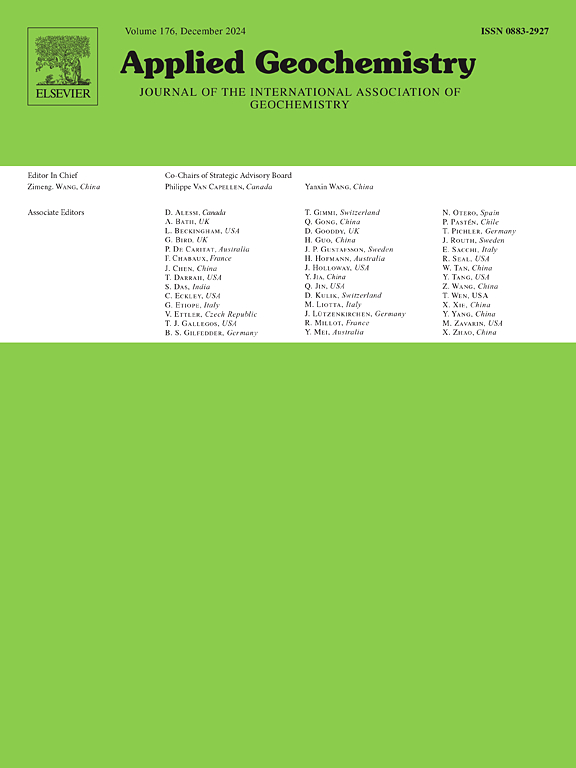Petrogenesis and prospecting implications of early Permian Daqishan plutons in the Beishan region, southern Central Asian Orogenic Belt, NW China: constraints from zircon U–Pb geochronology and petrogeochemistry
IF 3.4
3区 地球科学
Q1 GEOCHEMISTRY & GEOPHYSICS
引用次数: 0
Abstract
The Beishan Orogenic Belt, as a critical component of the Central Asian Orogenic Belt (CAOB), holds pivotal significance for understanding the tectonic evolution of the CAOB. The Beishan region records multiphase tectono-magmatic events spanning from the Proterozoic to the Mesozoic. Magmatic flux peaked during the Early Paleozoic and Early Mesozoic, accompanied by the formation of numerous Cu–Ni and Cu–Au deposits. Early Permian magmatic rocks in the Beishan region exhibit restricted spatial distribution and have a relatively lower degree of research. This study integrates geochronological, petrochemical, and zircon geochemical analyses of Permian plutons exposed in the Daqishan area, Beishan, Gansu Province. Research on the monzogranite (274.1–279.6 Ma), quartz diorite (271.8 Ma), and dacite porphyry (273.2–274.1 Ma) from the Yin'aoxia and Luotofang areas in the Daqishan region has revealed that the zircon U–Pb ages of these rocks are relatively concentrated. This indicates that there was a relatively intense magmatic activity in the Daqishan area during the Early Permian (between 270 and 280 Ma), with an emplacement sequence of monzogranite → dacite porphyry → quartz diorite. The monzogranite exhibits high SiO2 (69.5–78.1 wt%), Al2O3 enrichment (11.9–14.3 %), and low CaO (0.6–3.7 %) and TiO2 (0.1–0.4 %), classifying as calc-alkaline to high-K calc-alkaline series. The dacite porphyry shows moderate SiO2 (69.0–71.0 wt%), low K2O (0.7–2.8 wt%), elevated Na2O (4.9–5.3 wt%) and Al2O3 (14.4–15.0 wt%), belonging to tholeiitic to calc-alkaline series. The quartz diorite displays lower SiO2 (63.9–69.0 wt%) but higher Al2O3 (14.5–17.3 wt%), TFe2O3 (3.5–4.1 wt%), MgO (1.1–1.6 wt%), and CaO (2.7–2.9 wt%), characterized by Na-enrichment and classified as tholeiitic-calc-alkaline series. Together with the monzogranite, both are classified as I-type granites. All three rock types have A/CNK >1.1 and A/NK > 1.1, indicating their peraluminous nature. These rocks exhibit volcanic arc signatures and are interpreted as post-collisional products derived from deep crustal melting maybe with mantle contribution and subduction-related fluid metasomatism. Zircon crystallization temperatures decrease sequentially from quartz diorite to dacite porphyry to monzogranite. The Ce4+/Ce3+ ratios (monzogranite: 57.17; quartz diorite: 47.42; dacite porphyry: 75.25) suggest low oxygen fugacity (fO2) conditions for all three rock types. The Early Permian magmas in Daqishan are highly differentiated (whole-rock SiO2 >70 wt%) with low fO2, water-poor signatures (V/Sc < 9). Minor sphalerite grains observed in thin sections suggest that the intrusions underwent post-magmatic processes. These characteristics indicate that the Early Permian plutons in the Daqishan area exhibit limited potential for Cu–Au mineralization but significant prospectivity for epithermal Ag–Pb–Zn deposits. This study enhances the current knowledge of petrogenetic characteristics, source regions, and tectonic settings of Early Permian plutons in the Beishan region, providing a theoretical foundation for future breakthroughs in mineral exploration.
中亚造山带南缘北山地区早二叠世大歧山岩体成因及找矿意义:锆石U-Pb年代学和岩石地球化学约束
北山造山带作为中亚造山带的重要组成部分,对了解中亚造山带的构造演化具有重要意义。北山地区记录了从元古代到中生代的多期构造岩浆活动。岩浆通量在早古生代和早中生代达到高峰,并形成了大量的铜镍和铜金矿床。北山地区早二叠世岩浆岩空间分布有限,研究程度相对较低。对甘肃北山大岐山地区二叠系岩体进行了年代学、石化学和锆石地球化学分析。对大祁山地区印小峡和洛托坊地区二长花岗岩(274.1 ~ 279.6 Ma)、石英闪长岩(271.8 Ma)和英安岩斑岩(273.2 ~ 274.1 Ma)的锆石U-Pb年龄研究表明,这些岩石的锆石U-Pb年龄较为集中。表明早二叠世(270 ~ 280 Ma),大祁山地区岩浆活动较为强烈,侵位顺序为二长花岗岩→英安斑岩→石英闪长岩。二长花岗岩SiO2含量高(69.5 ~ 78.1 wt%), Al2O3富集(11.9 ~ 14.3%),CaO含量低(0.6 ~ 3.7%),TiO2含量低(0.1 ~ 0.4%),属于钙碱性-高钾钙碱性系列。英安岩斑岩SiO2含量中等(69.0 ~ 71.0 wt%), K2O含量低(0.7 ~ 2.8 wt%), Na2O含量高(4.9 ~ 5.3 wt%), Al2O3含量高(14.4 ~ 15.0 wt%),属于拉斑岩—钙碱性系列。石英闪长岩SiO2含量低(63.9 ~ 69.0 wt%), Al2O3含量高(14.5 ~ 17.3 wt%), TFe2O3含量高(3.5 ~ 4.1 wt%), MgO含量高(1.1 ~ 1.6 wt%), CaO含量高(2.7 ~ 2.9 wt%),以na富集为特征,属拉斑—钙—碱性系列。与二长花岗岩一起,均为i型花岗岩。三种岩石类型均为A/NK >;1.1和A/NK >;1.1,表明其过铝性质。这些岩石具有火山弧特征,可能与地幔贡献和俯冲相关的流体交代作用有关,被解释为深部地壳熔融的碰撞后产物。从石英闪长岩到英安岩斑岩到二长花岗岩,锆石结晶温度依次降低。Ce4+/Ce3+比值(二长花岗岩:57.17;石英闪长岩:47.42;英安岩斑岩:75.25)表明三种岩石类型的氧逸度(fO2)条件均较低。大祁山早二叠世岩浆分异程度高(全岩SiO2 >;70 wt%),具有低fO2、贫水特征(V/Sc <;9)。在薄片上观察到少量闪锌矿颗粒,表明侵入岩经历了岩浆后的作用。这些特征表明,大岐山地区早二叠世岩体的铜金成矿潜力有限,但浅成热液型银铅锌矿远景广阔。本研究充实了目前对北山地区早二叠世岩体成因特征、源区、构造背景等方面的认识,为今后矿产勘查工作的突破提供了理论基础。
本文章由计算机程序翻译,如有差异,请以英文原文为准。
求助全文
约1分钟内获得全文
求助全文
来源期刊

Applied Geochemistry
地学-地球化学与地球物理
CiteScore
6.10
自引率
8.80%
发文量
272
审稿时长
65 days
期刊介绍:
Applied Geochemistry is an international journal devoted to publication of original research papers, rapid research communications and selected review papers in geochemistry and urban geochemistry which have some practical application to an aspect of human endeavour, such as the preservation of the environment, health, waste disposal and the search for resources. Papers on applications of inorganic, organic and isotope geochemistry and geochemical processes are therefore welcome provided they meet the main criterion. Spatial and temporal monitoring case studies are only of interest to our international readership if they present new ideas of broad application.
Topics covered include: (1) Environmental geochemistry (including natural and anthropogenic aspects, and protection and remediation strategies); (2) Hydrogeochemistry (surface and groundwater); (3) Medical (urban) geochemistry; (4) The search for energy resources (in particular unconventional oil and gas or emerging metal resources); (5) Energy exploitation (in particular geothermal energy and CCS); (6) Upgrading of energy and mineral resources where there is a direct geochemical application; and (7) Waste disposal, including nuclear waste disposal.
 求助内容:
求助内容: 应助结果提醒方式:
应助结果提醒方式:


